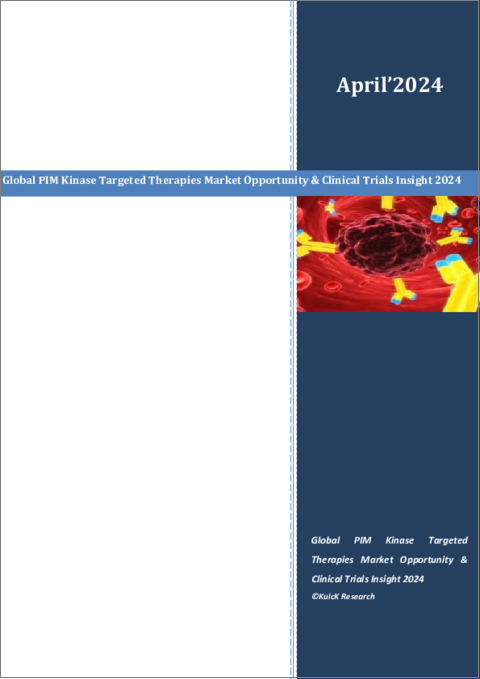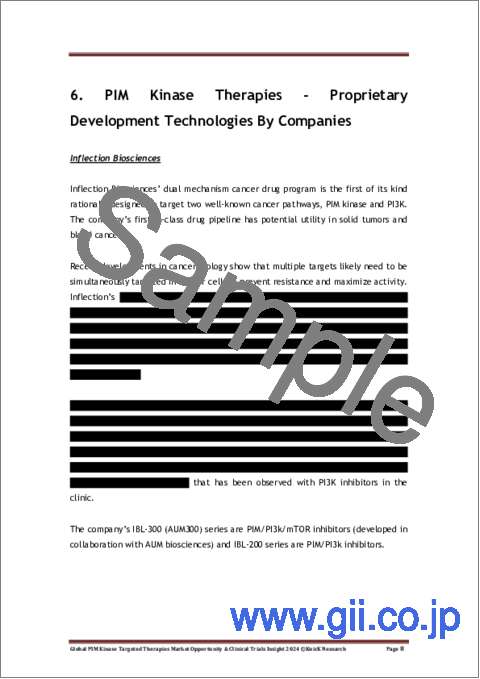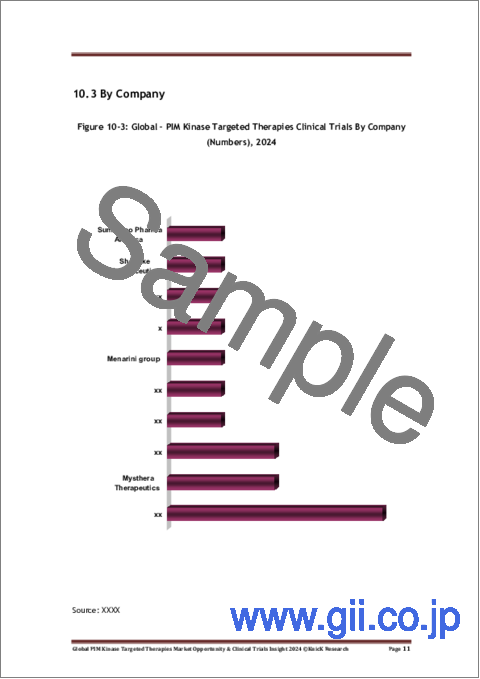|
|
市場調査レポート
商品コード
1473015
PIMキナーゼ標的治療の世界市場:市場機会と臨床試験に関する洞察(2024年)Global PIM Kinase Targeted Therapies Market Opportunity & Clinical Trials Insight 2024 |
||||||
|
|||||||
| PIMキナーゼ標的治療の世界市場:市場機会と臨床試験に関する洞察(2024年) |
|
出版日: 2024年05月01日
発行: KuicK Research
ページ情報: 英文 93 Pages
納期: 即日から翌営業日
|
全表示
- 概要
- 図表
- 目次
PIMキナーゼは3つのセリン/スレオニンプロテインキナーゼから構成され、がんやその他の疾患において極めて重要な役割を担っていることから、臨床・商業の両分野で大きな注目を集めています。有望な治療標的であるPIMキナーゼは、様々な疾患領域におけるアンメットメディカルニーズへの対処を目的とした標的治療の開発において、エキサイティングな展望を提供しています。PIMキナーゼ標的治療市場はまだ萌芽段階にありますが、現在進行中の調査努力は、この新しい薬剤クラスによる治療の実り多い将来性を指し示しています。
PIMキナーゼはモロニーマウス白血病ウイルスのプロウイルス挿入部位キナーゼの略で、細胞の生存、増殖、分化を制御する重要な役割を担っており、治療介入の魅力的な標的となっています。PIMキナーゼシグナル伝達の異常は、がん、自己免疫疾患、炎症性疾患、心血管疾患、ウイルス性疾患などに関与しており、その幅広い治療可能性が強調されています。そのため、PIMキナーゼを標的とすることで、多様な適応症に応用可能な新規治療法の開発が期待されます。
PIMキナーゼ阻害剤の開発は、標的治療の分野における重要なマイルストーンとなります。長年にわたり、PIMキナーゼを標的とする低分子阻害剤がいくつか開発されており、代表的な例としてはSGI-1776、MEN1703、SGI-1776、ETH-155008、JP11646などがあります。これらの候補薬は主にPIMキナーゼのATP結合ポケットを選択的に標的とし、その触媒活性を阻害し、疾患進行に関与する下流のシグナル伝達経路を阻害します。SGI-1776、ETH-155008のようないくつかの薬剤が臨床試験に進んだことは、PIMキナーゼを治療標的として利用することへの関心が高まっていることを強調するものであり、PIMキナーゼ阻害剤を商業化に向けて前進させる重要なマイルストーンとなります。
臨床試験に進んでいるPIMキナーゼ阻害剤の数は限られていますが、PIMキナーゼ標的治療法の展望は、前臨床開発中の候補化合物の強固なパイプラインによって特徴付けられています。数多くの企業や学術機関が、有効性と安全性を改善した新規阻害剤の同定を目的とした研究開発に積極的に取り組んでいます。現在進行中の臨床試験では、白血病、多発性骨髄腫、前立腺がんなどの様々ながん適応症や、全身性エリテマトーデスのような炎症性疾患におけるPIMキナーゼ阻害剤の安全性、忍容性、有効性が評価されています。
当レポートでは、世界のPIMキナーゼ標的治療市場について調査し、市場の概要とともに、適応症別、企業別、国別、相別動向、臨床試験動向、および市場に参入する企業の競合動向などを提供しています。
目次
第1章 PIMキナーゼ標的治療のイントロダクション
第2章 PIMキナーゼ標的治療アプローチ
- 低分子阻害剤
- PROTAC分解剤
- RNA干渉
- CRISPR/Cas9
第3章 がん治療におけるPIMキナーゼ標的治療の組み合わせ
- 化学療法
- 標的治療
- 放射線治療
- 免疫療法
第4章 診断および予後マーカーとしてのPIMキナーゼ
第5章 世界のPIMキナーゼ標的治療調査と市場動向、適応症別
- がん
- 自己免疫疾患および炎症性疾患
- 心血管疾患
- ウイルス性疾患
- 神経変性疾患
第6章 PIMキナーゼ療法- 企業別独自の開発技術
第7章 世界のPIMキナーゼ標的治療市場概要
第8章 PIMキナーゼ標的治療の研究開発動向、地域別
- 米国
- 欧州
- 日本
- 中国
第9章 PIMキナーゼ療法- FDA希少疾病指定、適応症別
第10章 世界のPIMキナーゼ阻害剤、臨床試験の概要
- 相別
- 国別
- 企業別
- 適応症別
- 患者セグメント
第11章 世界のPIMキナーゼ標的治療の臨床試験の洞察:企業、国、適応症、フェーズ別
- 前臨床
- 第I相
- 第I/II相
- 第II相
第12章 競合情勢
- Akros Pharma
- Biolexis Therapeutics
- Inflection Biosciences
- Menarini group
- Mysthera Therapeutics
- Novartis
- Shengke Pharmaceutics
- Sumitomo Pharma America
List of Figures
- Figure 1-1: PIM Kinase Targeted Therapies - Developmental Milestones
- Figure 2-1: PIM Kinase Targeted Therapy - Current Approaches
- Figure 2-2: PIM Kinase Small Molecule Inhibition - Future Opportunities
- Figure 2-3: PROTACs - Advantages
- Figure 2-4: PROTACs - Future Opportunities
- Figure 2-5: CRISPR/Cas9 - Benefits as a Therapeutic Modality
- Figure 2-6: Effects of CRISPR/Cas9-mediated DSB repair mechanism on PIM Kinase activity
- Figure 3-1: Combination of PIM Targeted Therapies & Chemotherapy - Benefits
- Figure 3-2: Combination of PIM Targeted therapies & Immunotherapy - Benefits
- Figure 5-1: PIM Kinases - Functions in Viral Infections
- Figure 6-1: Biolexis Therapeutics - MolecuLern Process
- Figure 7-1: PIM Kinase Targeted Therapies - Future Opportunities
- Figure 7-2: Global PIM Kinase Targeted Therapies Market - Drivers & Opportunities
- Figure 7-3: Global PIM Kinase Targeted Therapies Market - Challenges & Restraints
- Figure 9-1: Regulatory Designations - Benefits
- Figure 10-1: Global - PIM Kinase Targeted Therapies Clinical Trials By Phase (Numbers), 2024
- Figure 10-2: Global - PIM Kinase Targeted Therapies Clinical Trials By Country (Numbers), 2024
- Figure 10-3: Global - PIM Kinase Targeted Therapies Clinical Trials By Company (Numbers), 2024
- Figure 10-4: Global - PIM Kinase Targeted Therapies Clinical Trials By Indication (Numbers), 2024
- Figure 10-5: Global - PIM Kinase Targeted Therapies Clinical Trials By Patient Segment (Numbers), 2024
List of Tables
- Table 5-1: Cancer - PIM inhibitors in Clinical Development
- Table 5-2: Autoimmune & Inflammatory Disorders - PIM inhibitors in Clinical Development
- Table 5-3: Cardiovascular Diseases - PIM inhibitors in Clinical Development
- Table 9-1: PIM Kinase Therapies - FDA Orphan Designation By Indication
Global PIM Kinase Targeted Therapies Market Opportunity & Clinical Trials Insight 2024 Report Highlights:
- PIM Kinase Targeted Therapies In Clinical Trials: > 10 Therapies
- PIM Kinase Targeted Therapies Clinical Trials Insight By Company, Country, Indication & Phase
- USA Dominating PIM Kinase Targeted Therapies Clinical Trials Landscape: > 5 Therapies
- Role Of PIM Kinases as Diagnostic & Prognostic Markers
- FDA Orphan Designation To PIM Kinase Therapies By indication
- Proprietary Development Technologies By Companies
PIM kinases, comprising three serine/threonine protein kinases, have garnered significant attention in both clinical and commercial spheres due to their pivotal roles in cancer and other disease indications. As promising therapeutic targets, PIM kinases offer exciting prospects for the development of targeted therapies aimed at addressing unmet medical needs across various diseases area. Though the market of PIM kinase targeted therapies is still in a budding phase, ongoing research efforts point towards a fruitful future for this emerging drug class.
PIM kinases, standing for Proviral Insertion Site in Moloney Murine Leukemia Virus kinases, play crucial roles in regulating cell survival, proliferation and differentiation, making them attractive targets for therapeutic intervention. Dysregulated PIM kinase signaling has been implicated in cancer, autoimmune disorders, inflammatory conditions, cardiovascular diseases and viral diseases, highlighting their broad therapeutic potential. As such, targeting PIM kinases holds promise for development of novel treatments with potential applications across a diverse range of indications.
The development of PIM kinases inhibitors represents a significant milestone in the field of targeted therapy. Over the years, several small molecule inhibitors targeting PIM kinases have been developed, with notable examples including SGI-1776, MEN1703, SGI-1776, ETH-155008, JP11646. These candidates majorly target the ATP-binding pocket of PIM kinases selectively, inhibiting their catalytic activity and disrupting downstream signaling pathways implicated in disease progression. The advancement of some of these such as SGI-1776, ETH-155008 into clinical trials underscores the growing interest in exploiting PIM kinases as therapeutic targets and represents a key milestone in moving PIM kinase inhibitors towards commercialization.
While only a limited number of PIM kinase inhibitors have progressed to clinical trials, the landscape of PIM kinase targeted therapies is characterized by a robust pipeline of candidates in preclinical development. Numerous companies and academic institutions are actively engaged in research and development efforts aimed at identifying novel inhibitors with improved efficacy and safety profiles. Ongoing clinical trials are evaluating the safety, tolerability and efficacy of PIM kinase inhibitors in various cancer indications, including leukemia, multiple myeloma and prostate cancer, as well as inflammatory conditions like systemic lupus erythematosus.
Collaborations between pharmaceutical companies, academic institutions and research hospitals have been instrumental in driving progress in the development of PIM kinase targeted therapies. Academic institutions like University of Arizona, University of Leipzig, Ludwig Maximilians University Munich, University of Alabama, Ohio State University, Medical University of South Carolina and Pusan National University have over the years contributed valuable insights into the underlying biology of PIM kinases and their role in disease pathogenesis. Companies on the other hand bring expertise in drug discovery and development while hospitals serve as places to conduct clinical trials and additional research.
The development of RF-1302, a novel dual inhibitor of PIM-1 and FLT3 kinases, by the Chinese Academy of Medical Science and Tianjin Medical University General Hospital in partnership with Ruifu Therapeutics, serves as an example of this. The candidate is presently undergoing preclinical studies to treat acute myeloid leukemia. This kind of collaborative spirit encourages innovation and speeds up the translation of fundamental research discoveries into treatment interventions that have practical application. Companies and academic institutions can accelerate the commercialization of PIM kinase targeted therapies and optimize their potential by utilizing complementary capabilities and resources.
The market for PIM kinase targeted therapies looks to have a promising future with lots of scope to grow. Structure-based drug design and high-throughput screening are two examples of how drug discovery technologies are progressing and could lead to the development of new PIM kinase inhibitors with better potency and selectivity. Furthermore, the development of precision medicine strategies and biomarker-driven methodologies may make it possible to implement more individualized and focused treatment plans, improving the therapeutic utility of PIM kinase targeted therapies.
Additionally, novel treatment approaches may be discovered as a result of our growing understanding of PIM kinase biology and its significance in the pathophysiology of disease. PIM kinase targeted therapy development will be accelerated by industry-academia collaborations, which will ultimately benefit patients by offering more individualized and effective treatment alternatives. Because of this, the market for PIM kinase targeted therapies is anticipated to experience rapid expansion and innovation in the years to come, presenting intriguing prospects for players in the pharmaceutical sector.
Table of Contents
1. Introduction to PIM Kinase Targeted Therapy
- 1.1 Overview
- 1.2 History, Development & Evolution
2. PIM Kinase Targeted Therapy Approaches
- 2.1 Small Molecule Inhibitors
- 2.2 PROTAC Degraders
- 2.3 RNA Interference
- 2.4 CRISPR/Cas9
3. PIM Kinase Targeted Therapy Combinations for Cancer Treatment
- 3.1 Chemotherapy
- 3.2 Targeted Therapies
- 3.3 Radiotherapy
- 3.4 Immunotherapy
4. PIM Kinases as Diagnostic & Prognostic Markers
5. Global PIM Kinase Targeted Therapies Research & Market Trends by Indication
- 5.1 Cancer
- 5.2 Autoimmune & Inflammatory Disorders
- 5.3 Cardiovascular Diseases
- 5.4 Viral Diseases
- 5.5 Neurodegenerative Diseases
6. PIM Kinase Therapies - Proprietary Development Technologies By Companies
7. Global PIM Kinase Targeted Therapies Market Overview
- 7.1 Current Market Scenario
- 7.2 Future Commercialization Outlook
- 7.3 Favorable Developmental Parameters
- 7.4 Key Challenges & Restraints
8. PIM Kinase Targeted Therapies Research & Development Trends By Region
- 8.1 US
- 8.2 Europe
- 8.3 Japan
- 8.4 China
9. PIM Kinase Therapies - FDA Orphan Designation By Indication
10. Global PIM Kinase Inhibitor Clinical Trials Overview
- 10.1 By Phase
- 10.2 By Country
- 10.3 By Company
- 10.4 By Indication
- 10.5 Patient Segment
11. Global PIM Kinase Targeted Therapies Clinical Trials Insight By Company, Country, Indication & Phase
- 11.1 Preclinical
- 11.2 Phase I
- 11.3 Phase I/II
- 11.4 Phase II
12. Competitive Landscape
- 12.1 Akros Pharma
- 12.2 Biolexis Therapeutics
- 12.3 Inflection Biosciences
- 12.4 Menarini group
- 12.5 Mysthera Therapeutics
- 12.6 Novartis
- 12.7 Shengke Pharmaceutics
- 12.8 Sumitomo Pharma America





